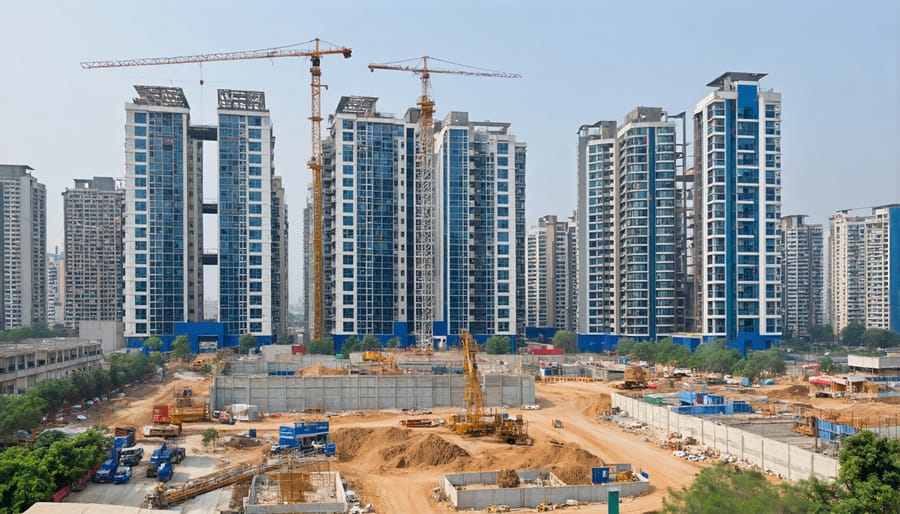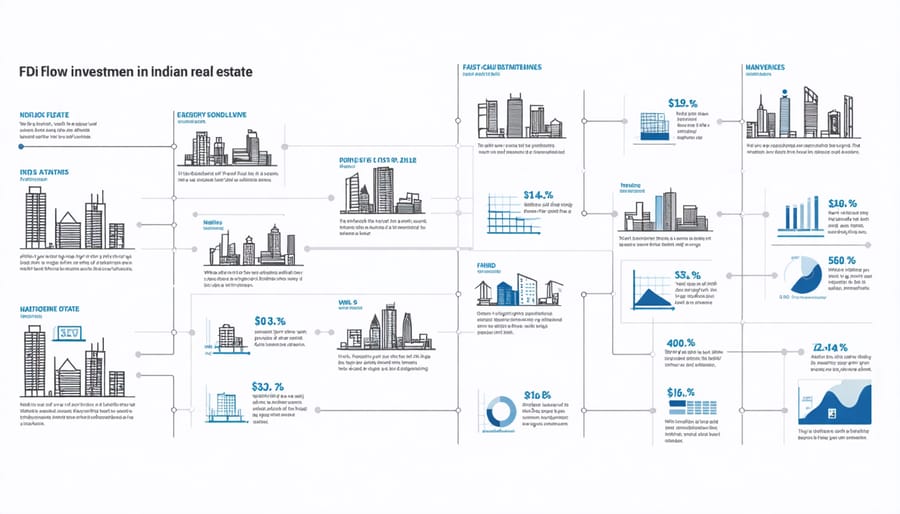India’s real estate sector stands at the cusp of unprecedented growth, propelling forward with a remarkable CAGR of 17.7% between 2023-2028. The industry, valued at USD 300 billion in 2023, demonstrates resilient expansion despite global economic headwinds, emerging as a cornerstone of India’s economic development. Driven by rapid urbanization, rising disposable incomes, and robust government initiatives like Smart Cities Mission and PMAY, the sector has transformed from a traditional housing market into a dynamic, technology-enabled ecosystem.
Strategic investments from global institutional investors, coupled with regulatory reforms like RERA and GST implementation, have injected transparency and professionalism into the market. The commercial real estate segment, particularly in tier-1 cities, exhibits exceptional growth potential, with office space absorption reaching 40.6 million square feet in 2023. The emergence of REITs, innovative financing mechanisms, and sustainable building practices further catalyze this growth trajectory.
This comprehensive analysis examines key growth drivers, market dynamics, and future projections that are reshaping India’s real estate landscape, offering valuable insights for industry stakeholders and investors positioning themselves in this rapidly evolving market.
Current Growth Trajectory and Market Performance

Statistical Overview
India’s real estate sector has demonstrated remarkable resilience and growth, with recent real estate market analysis indicating a robust 9.2% CAGR from 2021 to 2023. The market size reached USD 200.8 billion in 2023, marking a significant increase from USD 180.2 billion in 2022.
Residential real estate led the growth trajectory, accounting for 80% of the market share and exhibiting a 15.3% year-over-year increase in new project launches across major metropolitan areas. Commercial real estate followed with a 12.4% growth rate, primarily driven by the IT/ITeS sector’s expansion and increasing demand for Grade A office spaces.
The sector’s contribution to India’s GDP rose to 7.3% in 2023, up from 6.8% in 2022, reflecting its growing economic significance. Foreign Direct Investment (FDI) in construction development surged by 32% year-over-year, reaching USD 4.5 billion in 2023.
Tier-II and Tier-III cities emerged as significant growth drivers, recording a combined 18% increase in real estate development activities, outpacing the 11% growth observed in metropolitan areas. This geographical diversification indicates a maturing market with expanding opportunities across urban centers.
Sector-wise Performance
The Indian real estate market demonstrates distinct growth patterns across its major segments, with residential real estate leading the charge at 15.4% CAGR during 2022-23. Tier-1 cities witnessed particularly robust growth, with luxury housing showing an unprecedented 37% year-over-year increase. Mid-segment housing remains the market’s backbone, contributing to 48% of total residential sales.
Commercial real estate has emerged as a strong performer, recording 12.8% growth, primarily driven by the IT/ITeS sector and growing demand for Grade A office spaces. Major metropolitan areas like Bengaluru, Mumbai, and Hyderabad collectively absorbed 28.5 million square feet of commercial space in 2022, representing a 32% increase from the previous year.
The industrial segment, including warehousing and logistics facilities, demonstrated remarkable resilience with 9.6% growth. E-commerce expansion and manufacturing sector reforms have catalyzed demand for industrial real estate, particularly in emerging industrial corridors. Data centers emerged as a promising sub-segment, projecting 25% year-over-year growth through 2025.
Retail real estate showed signs of recovery post-pandemic, with 7.2% growth in 2022-23, marked by increasing demand for organized retail spaces in Tier-2 and Tier-3 cities. Mixed-use developments continue to gain traction, offering integrated living and working spaces that cater to evolving market preferences.
Key Growth Drivers
Urbanization and Demographics
India’s rapid urbanization has become a pivotal driver of real estate industry growth, with urban populations expected to reach 600 million by 2030. This demographic shift is creating unprecedented demand for housing, commercial spaces, and infrastructure development across major metropolitan areas. The emergence of tier-2 and tier-3 cities as economic hubs has diversified investment opportunities beyond traditional markets like Mumbai, Delhi, and Bangalore.
The government’s emphasis on smart city development initiatives has accelerated urban infrastructure modernization, attracting both domestic and international investors. This transformation is particularly evident in cities like Pune, Ahmedabad, and Chandigarh, where improved connectivity and economic opportunities are driving population influx.
The millennial workforce, comprising 34% of India’s total population, is reshaping real estate preferences with increased demand for mixed-use developments and integrated townships. This demographic dividend has spurred innovation in residential formats, with compact homes and co-living spaces gaining traction in urban centers.
Recent data indicates that 43% of India’s population will reside in urban areas by 2035, necessitating approximately 25 million additional housing units. This urban transformation is creating sustained demand across residential, commercial, and retail segments, making India’s real estate sector increasingly attractive for long-term investment strategies.
Government Initiatives and Policies
The Indian government has implemented several transformative policies to foster sustainable growth in the real estate sector. The Real Estate (Regulation and Development) Act (RERA) of 2016 stands as a cornerstone reform, establishing transparency and accountability while protecting homebuyer interests. This regulatory framework has significantly boosted investor confidence and standardized industry practices.
The Pradhan Mantri Awas Yojana (PMAY) initiative continues to drive affordable housing development, with ambitious targets to address urban housing shortages. Through interest subsidies and tax incentives, the scheme has catalyzed residential construction across tier-2 and tier-3 cities.
Recent policy measures, including the reduction in GST rates for under-construction properties and the establishment of Alternative Investment Funds (AIF) worth ₹25,000 crore, have provided crucial liquidity support to the sector. The government’s emphasis on infrastructure development through programs like Smart Cities Mission and AMRUT has created additional growth opportunities for real estate developers.
Foreign Direct Investment (FDI) policies have been progressively liberalized, allowing 100% FDI through the automatic route in completed projects and construction development projects. This has attracted significant international investment, particularly in commercial real estate and integrated township projects.
The introduction of Real Estate Investment Trusts (REITs) has opened new funding channels, enabling smaller investors to participate in commercial real estate opportunities while providing developers with alternative financing options.
Investment Landscape
Foreign Direct Investment
Foreign Direct Investment (FDI) in India’s real estate sector has witnessed remarkable growth, with inflows reaching $51.47 billion between April 2000 and December 2022. The government’s liberalized FDI policy, allowing 100% FDI through the automatic route in completed projects, has significantly boosted international investor confidence.
Major global investment firms, including Blackstone, Brookfield, and GIC, have demonstrated strong interest in Indian real estate, particularly in commercial properties and logistics parks. Recent trends show increased investment in emerging asset classes like data centers, warehousing, and mixed-use developments.
The sector has attracted substantial institutional investment, with private equity investments totaling $4.8 billion in 2022 alone. Notable transactions include Brookfield’s $2 billion investment in commercial properties and Blackstone’s strategic acquisitions in major metropolitan areas.
Market analysts project continued growth in FDI inflows, driven by India’s robust economic fundamentals, urbanization trends, and improving regulatory framework. The Real Estate Regulatory Authority (RERA) implementation has enhanced transparency and accountability, making the market more attractive to foreign investors.
Key growth markets include Bengaluru, Mumbai, and Delhi-NCR, which collectively account for approximately 75% of total FDI in real estate. The trend indicates a strong preference for Grade A commercial properties and integrated townships.

Domestic Investment Trends
Domestic investment in India’s real estate sector has shown remarkable resilience and growth, with institutional funding reaching ₹27,650 crore in 2022, marking a 32% year-over-year increase. Private equity investments have emerged as a significant driver, with domestic investors contributing approximately 65% of total real estate investments across major metropolitan areas.
Institutional investors, particularly pension funds and insurance companies, have demonstrated increased confidence in the sector, allocating substantial portions of their portfolios to commercial and residential real estate assets. The emergence of Real Estate Investment Trusts (REITs) has created a new avenue for domestic capital deployment, with three successful REIT listings attracting over ₹8,400 crore in investments.
Alternative investment funds focusing on real estate have grown substantially, with assets under management reaching ₹1.8 lakh crore in 2022. The residential sector has attracted the largest share of domestic investments at 48%, followed by commercial real estate at 32% and industrial/warehousing at 15%.
Local developers and construction firms have also increased their capital expenditure, with many establishing dedicated investment arms to participate in larger projects. This trend reflects growing confidence in the sector’s long-term potential and the effectiveness of regulatory reforms in creating a more transparent investment environment.
Technological Integration

PropTech Innovations
The Indian real estate sector is witnessing a technological revolution with PropTech innovations driving efficiency and transparency. Advanced AI-powered property market analysis tools are enabling developers and investors to make data-driven decisions with unprecedented accuracy. Virtual and augmented reality technologies have transformed property showcasing, allowing potential buyers to experience spaces remotely, a trend that gained significant momentum during the pandemic.
Blockchain technology is revolutionizing property transactions by enabling smart contracts and secure digital documentation, reducing processing times by up to 60%. IoT integration in commercial and residential properties is enhancing building management systems, leading to improved energy efficiency and reduced operational costs.
Construction technologies like 3D printing and modular construction are gaining traction, with several major developers incorporating these innovations to reduce project timelines by 30-40%. Digital platforms for property management and maintenance are streamlining operations, while AI-driven chatbots are improving customer service response times by 80%. These technological advancements are not just enhancing operational efficiency but are also contributing to the sector’s sustained growth trajectory.
Digital Transformation
Digital transformation is revolutionizing India’s real estate sector, with PropTech solutions driving operational efficiency and enhancing customer experience. The adoption of Building Information Modeling (BIM) technology has increased by 67% among leading developers, enabling better project visualization and reducing construction errors. Smart home technologies and IoT integration have become standard features in premium residential projects, commanding 15-20% higher valuations.
Property management platforms and virtual reality tours gained significant traction during the pandemic, with 78% of developers now offering virtual property viewings. Blockchain technology is emerging as a game-changer for property documentation and transactions, with several state governments piloting blockchain-based land registry systems.
AI-powered analytics are helping developers optimize pricing strategies and predict market trends with greater accuracy. Construction companies are increasingly utilizing drones and automated equipment for site monitoring and quality control, resulting in a 23% improvement in project delivery timelines. Mobile applications for property maintenance and tenant management have seen a 156% growth in adoption rates since 2020, indicating a strong shift towards digital-first operations in the real estate sector.
Future Outlook and Projections
Industry experts project India’s real estate sector to reach USD 1.3 trillion by 2025, demonstrating a compound annual growth rate (CAGR) of 15.2% between 2023 and 2028. This robust growth trajectory aligns with broader global real estate market trends, though India’s expansion rate significantly outpaces many developed markets.
The residential segment is expected to lead this growth, with tier-2 and tier-3 cities emerging as significant contributors. Market analysis indicates these secondary markets could achieve a CAGR of 18% through 2025, driven by improved infrastructure development and the government’s Smart Cities initiative.
Commercial real estate, particularly the office sector, is projected to add approximately 40-45 million square feet annually over the next five years. The IT/ITeS sector will remain the primary demand driver, while emerging sectors like healthcare and logistics are expected to increase their real estate footprint substantially.
The affordable housing segment presents a particularly promising outlook, with an estimated demand of 25 million units by 2030. Government initiatives like PMAY (Pradhan Mantri Awas Yojana) and tax incentives for affordable housing developers will continue to catalyze growth in this sector.
Digital transformation and sustainable development will shape future growth patterns. Industry forecasts suggest that green building projects could comprise 50% of all new construction by 2025, while PropTech investments are expected to reach USD 1 billion annually by 2025, revolutionizing project delivery and asset management practices.
India’s real estate sector demonstrates remarkable resilience and growth potential, with projections indicating a CAGR of 9.2% through 2028. The industry’s expansion is underpinned by robust urbanization, rising disposable incomes, and supportive government policies. Key findings reveal that tier-2 and tier-3 cities are emerging as significant growth drivers, while technological integration and sustainable development practices are reshaping traditional construction approaches.
The implications for industry stakeholders are substantial. Developers must adapt to evolving consumer preferences, particularly in sustainable and smart housing solutions. Investment opportunities remain strong, with foreign direct investment regulations becoming increasingly favorable. The affordable housing segment continues to present significant growth potential, supported by government initiatives and rising demand.
Looking ahead, the sector’s trajectory suggests a transformation phase, with digital innovation and sustainable practices becoming essential components of success. Industry players who embrace these changes while maintaining focus on quality and timely delivery will be better positioned to capitalize on the market’s growth potential. The confluence of policy support, technological advancement, and market demand indicates a promising future for India’s real estate sector.

